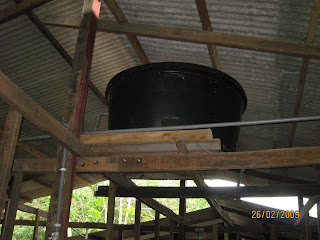
Bear in mind that the pen size is 10 feet long and 7 feet width. So the rows length would be in multiple of 10 feet and the width of 7 feet remain the same. For a capacity of 100 goats (about 40 adults and 60 kids), we need 8 normal size pens and 10 pregnancy pens. (Be ready to expand the barn or build a second barn in the second year).
Build the normal size pens in two rows (i.e. 4 each row) and one row for pregnancy pens. While building the first barn, you must consider its expansion. Orientation of the barn is important for easy future expansion. Let us assume the rows run from north to south. There will be 2 rows of normal size pens and 1 pregnancy pen running from north to south...

6. Provision for Food Trough

The trough should be built on one side of each row and must be continuous from one end to another end without any break in between. What about door for each pen? The doors should be built from the other side of the row. In this way, the food trough would be in one side and the doors in another side of the row. Assuming y ou have the basic 3 rows barn, the middle row will have their food trough facing the first row and its doors facing the pregnancy pens doors. The first row will have its doors facing west side of the barn and the pregnancy row will have its food trough facing east side of the barn. Make a provision of 1.5 to 2 feet for service walkway on the outside perimeter of the barn and also between the the food trough. Make another provision of 2 to 2.5 feet between the middle row and the pregnancy row. The width of the food trough is 20 inches edge-to-edge.
ou have the basic 3 rows barn, the middle row will have their food trough facing the first row and its doors facing the pregnancy pens doors. The first row will have its doors facing west side of the barn and the pregnancy row will have its food trough facing east side of the barn. Make a provision of 1.5 to 2 feet for service walkway on the outside perimeter of the barn and also between the the food trough. Make another provision of 2 to 2.5 feet between the middle row and the pregnancy row. The width of the food trough is 20 inches edge-to-edge.
 ou have the basic 3 rows barn, the middle row will have their food trough facing the first row and its doors facing the pregnancy pens doors. The first row will have its doors facing west side of the barn and the pregnancy row will have its food trough facing east side of the barn. Make a provision of 1.5 to 2 feet for service walkway on the outside perimeter of the barn and also between the the food trough. Make another provision of 2 to 2.5 feet between the middle row and the pregnancy row. The width of the food trough is 20 inches edge-to-edge.
ou have the basic 3 rows barn, the middle row will have their food trough facing the first row and its doors facing the pregnancy pens doors. The first row will have its doors facing west side of the barn and the pregnancy row will have its food trough facing east side of the barn. Make a provision of 1.5 to 2 feet for service walkway on the outside perimeter of the barn and also between the the food trough. Make another provision of 2 to 2.5 feet between the middle row and the pregnancy row. The width of the food trough is 20 inches edge-to-edge. Important Note:
The trough is made of thick canvas. This material is very strong. It can withstand the weight of any goat running inside it without any breaking. Most important it will be very convenient for cleaning job every morning. When it clean, we can rest assure that the goat will be eating in a clean environment. As a result our goat will be more healthy. Many farmers still sceptical about using canvas as the food trough. Most of them still using the old technique of using wooden planks or the new ones using rain gutter or big PVC pipes cut into halves. Those materials needs frequent maintenance, wrong sizing will result in insufficient quantity of food, cleaning will not be as quick and as clean as using canvas. This little extra investment will provide long term benefits in work efficiency and cost saving.



















































